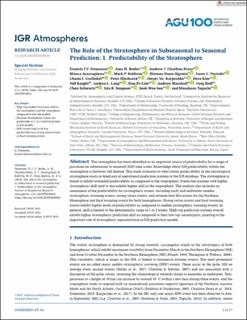The Role of the Stratosphere in Subseasonal to Seasonal Prediction: 1. Predictability of the Stratosphere
Domeisen, Daniela; Butler, Amy; Charlton-Perez, Andrew; Ayarzaguena, Blanca; Baldwin, Mark; Dunn-Sigouin, Etienne; Furtado, Jason; Garfinkel, Chaim; Hitchcock, Peter; Karpechko, Alexey; Kim, Hera; Knight, Jeff; Lang, Andrea; Lim, Eun-Pa; Marshall, Andrew; Roff, Greg; Schwartz, Chen; Simpson, Isla; Son, Seok-Woo; Taguchi, Masakazu
Journal article, Peer reviewed
Published version

Åpne
Permanent lenke
https://hdl.handle.net/11250/2759774Utgivelsesdato
2019-11-18Metadata
Vis full innførselSamlinger
- Geophysical Institute [1198]
- Registrations from Cristin [9791]
Originalversjon
Journal of Geophysical Research (JGR): Atmospheres. 2020, 125 (2), 1-17 https://doi.org/10.1029/2019JD030920Sammendrag
The stratosphere has been identified as an important source of predictability for a range of processes on subseasonal to seasonal (S2S) time scales. Knowledge about S2S predictability within the stratosphere is however still limited. This study evaluates to what extent predictability in the extratropical stratosphere exists in hindcasts of operational prediction systems in the S2S database. The stratosphere is found to exhibit extended predictability as compared to the troposphere. Prediction systems with higher stratospheric skill tend to also exhibit higher skill in the troposphere. The analysis also includes an assessment of the predictability for stratospheric events, including early and midwinter sudden stratospheric warming events, strong vortex events, and extreme heat flux events for the Northern Hemisphere and final warming events for both hemispheres. Strong vortex events and final warming events exhibit higher levels of predictability as compared to sudden stratospheric warming events. In general, skill is limited to the deterministic range of 1 to 2 weeks. High-top prediction systems overall exhibit higher stratospheric prediction skill as compared to their low-top counterparts, pointing to the important role of stratospheric representation in S2S prediction models.